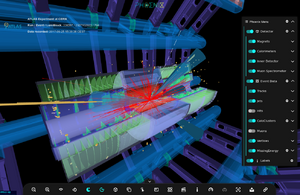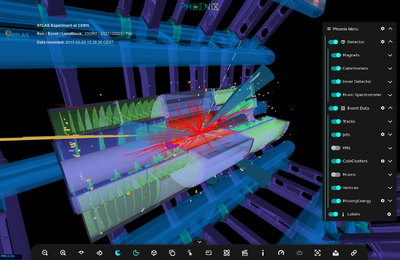Software:Phoenix event display
Phoenix is web-based event display library [1] for visualizing data from particle accelerator. The application is written in JavaScript and utilities the Three.JS Web Graphics Library. It is experiment agnostic by design, with common tools (such as custom menus, controls, propagators) and the possibility to add experiment specific extensions. The library is supported by the HEP Software Foundation (HSF).
The Phoenix visualization library is used to create the official web event display called PhoenixATLAS for the Atlas experiment, the largest, general-purpose particle detector experiment at the Large Hadron Collider (LHC), a particle accelerator at CERN (the European Organization for Nuclear Research) in Switzerland. Similarly, the library is used to visualise CMS and LHCb detectors.
 | |
 Example of visualized pp collision in ATLAS detector | |
| Original author(s) | HEP Software Foundation |
|---|---|
| Initial release | 2019 |
| Stable release | 1.
/ April 2021 |
| Written in | JavaScript |
| Operating system | Cross-platform |
| Available in | English |
| License | Open source (GPLv3 or later, GPL and similar) |
| Website | hepsoftwarefoundation |
The application was divided on several components, such as:
- Playground - tutorial to started with the different Phoenix features.
- Geometry display - tutorial to show some simple geometry
- PhoenixATLAS - event display for the ATLAS experiment
- PhoenixLHCb - shows the LHCb detector
- PhoenixCMS - shows the CMS detector
- TrackML - visualisation for TrackML. Shows how to write a custom event loader.
Here is an example of a proton-proton (pp) collision event created for public display by the CERN collaboration. The application can visualize the detector parts, as well as relevant objects (calorimeter clusters, charged tracks) created during the collision of high-energetic protons at 13 TeV centre-of-mass collision energy.
See also
- ATLANTIS event display implemented in Java used for visualization of events for future colliders;
- Tracer detector display event display implemented in JavaScript for the ATLAS collaboration
External links
- Phoenix Github repository: Github repository
References


